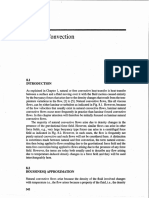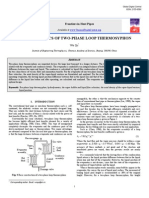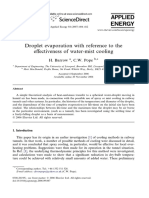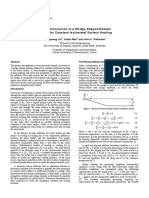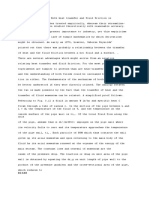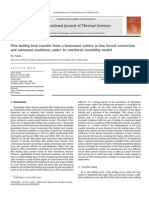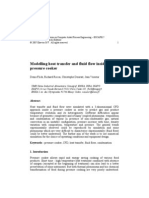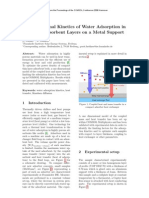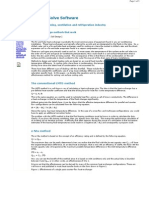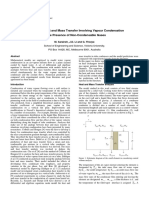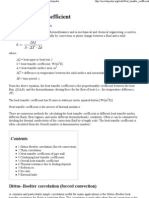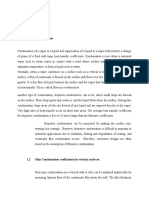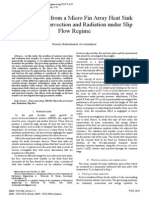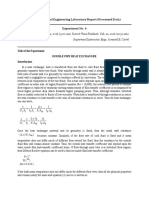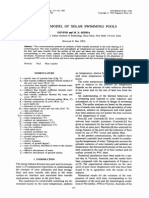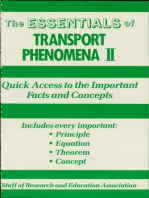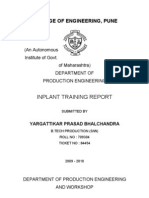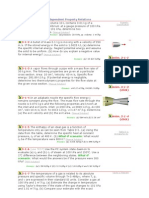Steam Hammer - Theory
Steam Hammer - Theory
Uploaded by
ktsnlCopyright:
Available Formats
Steam Hammer - Theory
Steam Hammer - Theory
Uploaded by
ktsnlOriginal Description:
Original Title
Copyright
Available Formats
Share this document
Did you find this document useful?
Is this content inappropriate?
Copyright:
Available Formats
Steam Hammer - Theory
Steam Hammer - Theory
Uploaded by
ktsnlCopyright:
Available Formats
Initiation of Water Hammer in a Steam/Water Pipe with a
Non-Condensable Gas
J iann-Lin Chen
1,*
Tzu-Chen Hung
1
S. Kong Wang
1
Bau-Shi Pei
2
1
Dept. of Mechanical and Automation Engineering, I Shou University,
Da-Shu, Kaohsiung, Taiwan
2
Dept. of System and Engineering Science, National Tsing-Hua University. Hsing-Chu, Taiwan
*
Corresponding Author
james88@isu.edu.tw http://www.isu.edu.tw
Abstract: The effect of a non-condensable gas on the initiation of water hammer in a condensing water-steam
system has been investigated by extending Bjorges work. Based on computational results, it is concluded
that the pipe slope is the dominant parameter which affects the initiation of water hammer. The effective
temperature difference in driving energy across the liquid interface was found to be instead of
previously accepted expression of . As a result, the effect of the subcooling of inlet liquid in
inducing water hammer is not always a favorable factor. The effects of the parameters including liquid flow
rate, pipe length, and diameter are similar to Bjorges conclusion. Nusselt number is used and correlated
directly by mass transfer theory. More experiments are needed in order to find a more accurate correlation of
the occurrence of water hammer.
(
b
l i
T T )
) (
a
l sat
T T
Key Words: Water hammer, Condensation, Non-condensable gas, Daitel-Dukler parameter.
1 Introduction
Bjorge [1] developed a one- dimensional flow
model to describe the initiation mechanism
associated with water hammer induced by collapsing
of steam bubbles in a pipe containing steam and
subcooled water. He defined an absolute stability
limit which is a conservative prediction of water
hammer formation. This limit is postulated as the
minimum liquid flow rate needed to satisfy the
so-called Taitel-Dukler [2] criterion, assuming that
the subcooled liquid entering a pipe is quickly heated
up to saturation temperature by steam flow.
A mathematic model for predicting the
occurrence of water hammer in a large circular
piping system has been established. The parameters
such as liquid depth, liquid temperature and steam
mass flow rate, all along the pipe, are investigated.
Taitel-Duklers [2] criterion is employed to predict
whether the occurrence of water hammer will initiate
or not. A computer code was developed to solve the
mathematicam model. In case the computer code
does not yield a convergent solution for some cases,
the Wallis [3] full limit analysis can also be
introduced to assess if water hammer occurs.
J ackobek and Griffith [4] followed the
methodology developed by Bjorge and
calculated the impact velocity and peak pressure
rise during the course of the occurrence of water
Proceedings of the 3rd IASME/WSEAS Int. Conf. on HEAT TRANSFER, THERMAL ENGINEERING AND ENVIRONMENT, Corfu, Greece, August 20-22, 2005 (pp265-270)
hammer by assuming: (a) zero pressure exists
inside the steam bubbles upon collapse; (b)
liquid plug velocities diminish upon impact; and
(c) condensation is the dominant process in
which the pressure is reduced. A threshold of
the steam mass flow rate is needed to achieve a
thermal equilibrium. It means that the energy
transferred from latent heat into sensible heat is
treated as an upper limit for energy mixing.
There are some researches related to the
transition from stratified flow to slug flow which is
the initiation state of water hammer. Kordyban et al
[5] concluded that, for given channel geometries and
fluid properties, the primary factors which would
influence this transition are gas velocity, liquid level,
wavelength, and wave height. Taitel-Dukler assumed
that the pressure difference on the wavy surface is
due to Bernoulli effect. They postulated that slug
formation would occur when the pressure difference
was large enough to overcome the gravity force
acting on the wave. Mishima and Ishii [6] postulated
that a stability criterion is obtained by introducing the
wave deformation limit and the most dangerous
wave concept in stability analysis.
Minkowycz and Sparrow [7,8] found that the
presence of non-condensable gas can reduce the
condensation rate based on their boundary layer
experiment. This may be a practical way to prevent
the initiation of water hammer. The non-condensable
gas provides a void space, equivalent to a buffer, to
reduce the impact velocity and simultaneously
reduce the peak pressure.
2 Condensation Phenomena with the
Presence of Non-condensable Gas
for flat plate
The current study investigates the effect of the
non-condensable gas in a stratified-flow
condensation system by extending Bjorges work.
Base on previous researches, it is generally accepted,
in a steam piping system, water hammer is initiated
mainly by a rapid condensation rate. In light of this,
it is considered feasible to inhibit the initiation of
water hammer by adding a small fraction of
non-condensable gas into the concerned system.
Now, consider stationary fluids covering an
infinite flat plate with a constant temperature while
vapor is condensing on the liquid/vapor interface.
Based on conservation of energy, heat transfer
per unit width of the plate can be expressed as:
fg l fg v f
dxh u h m d dx
T
k
= =
&
In which,
w sat
T T T = ; dt d u = .
Therefore, it yields
dt
h
T k
d
fg l
f
=
Then, heat flux can be obtained by introducing depth
o
with respect to time t
o
, and it yields
( ) ( )
( )( )
2 / 1
2
2
=
o
fg l
o w sat f
w sat f w sat f
h
t t T T k
T T k T T k
q
(1)
By including mass transfer with the presence of a
non-condensable gas, it can be obtained from [10],
( )
4 / 1
4 . 0 1
425 . 0
+
=
l
l
vi v m fg
m
Ja
Ja
GrSc
m m D h
Lc q
(2)
where
( )
v l
g
Lc
=
Substituting T
sat
in Eq.(4) by T
i
, it yields
( )
( )( )
2 / 1
2
2
=
o
fg l
o w i f
w i f
h
t t T T k
T T k
q
(3)
Equation (3) can be substituted back to Eq. (2) and T
i
can be solved by iteration. Finally, by taking the
ratio of heat fluxes expressed in Eq. (3) and Eq. (2),
the effect of the presence of a non-condensable gas
on heat transfer can be evaluated.
Proceedings of the 3rd IASME/WSEAS Int. Conf. on HEAT TRANSFER, THERMAL ENGINEERING AND ENVIRONMENT, Corfu, Greece, August 20-22, 2005 (pp265-270)
Now, consider a convective flow above an
infinite flat plate with a constant temperature while
vapor is condensing on the liquid/vapor interface.
Also by assuming a Prandtl number very close to
unity, the momentum boundary layer is then identical
to the thermal boundary layer. The boundary
conditions of the boundary layer are:
y = 0, T = T
w
and y = , T = T
sat
.
It can be obtained that
( )
=
y
T T T T
w sat sat
1
(4)
and the overall energy equation is
( )
+ =
=
=
0
0
1
dy T T uCp
m
h
dx
m d
y
T
k q
sat f f fg
y
f
&
&
(5)
where 3
max
0
3 3
2
= = =
x
P
u udy m
f
f
f f
&
By assuming a parabolic velocity distribution and
substituting Eq. (4) into Eq. (5), it yields
( )
+ =
= Ja h
dx
m d
T T k
q
fg
w sat f
8
3
1
&
(6)
where
dx
d
x
P
dx
m d
f
f
=
&
(7)
Substituting Eq. (7) into Eq. (6), then it yields
( )
Ja h
dx
d
x
P
T T k
fg
f
f w sat f
8
3
1
2
(8)
Equation (8) can be integrate to obtain with the
initial condition =
o
at x = 0, and then heat flux
will be
( )
( )
4 / 1
0
4
3
1
4
x
o
fg f
w sat f f
w sat f
dx
Ja h
P
T T k
T T k
q
8
x
(9)
The Nusselt number on a flat plate with a parallel
laminar flow is [10]:
33 . 0 2 / 1
Pr Re 332 . 0
x x
Nu = , 5 . 0 Pr
Therefore, the mass transfer with the existence of a
non-condensable gas becomes:
( )
33 . 0 5 . 0
Re 332 . 0 Sc
m m D h
x q
x
vi v m fg
m
=
(10)
With the similar processes as mentioned before, the
heat transfer rate with the consideration of the mass
transfer included becomes:
( )
( )
4 / 1
0
4
3
4
+
8
1
x
o
w i f f
w i f
m
dx
P
T T k
T T k
q
fg f
Ja h
x
(11)
Equation (11) can be substituted into Eq. (10), and T
i
can be obtained by iteration on Eq. (11). Note that
( )
x
P
and Re
x
are not determined yet and these
terms will be discussed in the following section.
3 Condensation Phenomena with the
Presence of Non-condensable Gas
for Circular Pipe
In generally, thermal layer available for mass
transfer at the vapor/liquid interface is very thin in
comparison with the pipe diameter [7]. The heat
flux in a circular pipe can be approximated by Eq.
(11) as long as the ratio of the liquid depth to the pipe
diameter is not too large. Also,
o
in Eq. (11) can be
set to zero since because heat transfer only occurs at
the liquid-vapor interface. By replacing T
w
to T
l
, Eq.
(11) is simplified to be:
( )
( )
4 / 1
0
4
x
l i f f
l i f
m
dx
h
P
T T k
T T k
q
fg f
x
(12)
where thermodynamic properties are evaluated with
respect to the liquid temperature. For mass transfer,
the Nusselt number is
( ) ( )
vi v m fg
m
vi v m
m
m m D h
D q
m m D
jD
Nu
=
(13)
Proceedings of the 3rd IASME/WSEAS Int. Conf. on HEAT TRANSFER, THERMAL ENGINEERING AND ENVIRONMENT, Corfu, Greece, August 20-22, 2005 (pp265-270)
where ( ) 2
+ =
i
. Several studies regarding
interfacial condensation heat transfer under a
condition of stratified flow of steam and subcooled
water have been listed in [1]. Here, Bankoffs
correlations is adopted:
42 . 0 49 . 0 027 . 0
1
Pr Re Re 236 . 0
l l v
C Nu = (14-a)
for smooth interface, and
16 . 1 56 . 0 1 . 2
1
10
Pr Re Re 10 17 . 1
l l v
C Nu
=
(14-b)
for rough interface. C
1
is 2.5 for circular pipe.
When considering mass transfer with the
existence of a non-condensable gas, the Prandtl
number Pr
l
and Reynolds number of the vapor phase
Re
v
should be replaced by Schmidt number Sc and
Reynolds number of the vapor-gas phase,
respectively. Here, Sc
v
/D
m
and Re
v&g
=
(uD
h
/)
v&g
where
v&g
=
v
m
v
+
g
m
g
,
gg g gv v
g g
vg g vv v
v v
g v
+
+
+
=
&
and
2 / 1
2
4 / 1
2 / 1
1 8
1
+
=
k
j
j
k
k
j
jk
M
M
M
M
(15)
The modified Bankoffs correlations for
condensation with the presence of a non-condensable
gas can therefore be expressed as a function of the
form
( )
42 . 0 027 . 0
&
49 . 0
&
Re Re 59 . 0 , Re , Re Sc Sc f Nu
g v l g v l m
= =
(16-a)
for a smooth interface, and
16 . 1 1 . 2
&
56 . 0 10
Re Re 10 925 . 2 Sc
g v l
= (16-b)
for a rough interface. Interfacial temperature can be
obtained by combining Eqs. (12), (13) and (16) and
undergoing iterative processes.
The pressure-gradient term in Eq. (12) was
derived by Bjorge [1] based on the momentum
balance of the liquid phase and by the assumption of
a negligible interfacial velocity.
( )
dx
d
A
s m
dx
m d
A
m
dx
d
g g s s
A dx
dP
l
l l
i l l
l l
l l
l l i i l l
l
& & &
+ + + + + =
2 1
(17)
where
fg
m l
h
q
dx
m d
=
&
;
( )
( ) +
+
=
1 1
1 2
2
* 2 *
&
* *
Fr
q Fr
dx
d
g v i l
l
,
l
g v
u
u
&
1
=
,
( )
2
&
2
1
l l
g v
u
u
=
,
fg l
m
h m
q
q
&
=
*
and
3 2
2
2
l l
i l
gA
s m
Fr
&
=
.
The liquid temperature varies along the pipe distance
by solving the following equation,
dx
dq
Cp m dx
dT
m
l l
l
&
1
=
(18)
4 Results and Discussion
As was predicted, the presence of a small
quantity of a non-condensable gas in the condensing
vapor significantly increases thermal resistance at the
liquid-vapor interface. As shown in Fig. 1, Nusselt
number is in general reduced by a factor of 10
5
when
argon gas with a small amount of just 0.5% in
pressure fraction is introduced. This is due to a
dramatically increased mass transfer barrier imposed
on condensation. Figure 2 shows the corresponding
curves for Taitel-Dukler parameter in the prediction
of the initiation of water hammer. It is apparent that
the occurrence of water hammer in significantly
inhibited when a non-condensable gas is present.
The effect of liquid subcooling on the initiation
of water hammer is shown in Fig. 3, and it shows that
a higher liquid subcooling would yield lower values
of Taitel-Dukler parameter. This result is contrary
to the case where a non-condensable gas is absent.
This is because that heat transfer is proportional to
( )
b
l i
T T instead of ( )
a
l sat
T T when a
non-condensable gas is present. The interfacial
temperature T
i
is always a little higher than liquid
Proceedings of the 3rd IASME/WSEAS Int. Conf. on HEAT TRANSFER, THERMAL ENGINEERING AND ENVIRONMENT, Corfu, Greece, August 20-22, 2005 (pp265-270)
temperature. Thus, the effect of subcooling is
negligible compared to the effect of the variation in
thermophysical properties as determined by the
system conditions. A liquid with a higher
temperature will have a lower viscosity and hence a
higher Reynolds number, and, according to Eqs. (12),
(13), and (16), a higher Nusselt number and a higher
Taitel-Dukler parameter.
The effect of pipe slope on Taitel-Dukler
parameter is shown in Fig. 4, and it shows that even a
small angle of pipe slope will remarkably increase
the possibility of the initiation of water hammer.
Similar to Bjorges conclusion, increasing liquid flow
rate and pipe length will increase the possibility of
the initiation of water hammer. However, the
effects are not very obvious.
5 Conclusion and Suggestions
The presence of a non-condensable gas in a
condensing water-steam system with the occurrence
of stratified flow has been investigated by extending
Bjorges work. A mathematic model for this
condensation phenomena occurred in a large circular
piping system has been established and its solution
scheme has been programmed.
Based on computational results, it is concluded
that the pipe slope is the dominant parameter which
affects the initiation of water hammer. The effective
temperature difference in driving energy across the
liquid interface was found to be instead
of . As a result, the effect of the
subcooling of the inlet liquid in inducing water
hammer is not always a favorable factor. The
effects of liquid flow rate, pipe length, and diameter
are similar to Bjorges conclusion. Nusselt number is
used and correlated directly by mass transfer theory.
More experiments are needed in order to find a more
accurate correlation of the occurrence of water
hammer.
(
b
l i
T T )
) (
a
l sat
T T
References:
[1] R.W. Bjorge, Initiation of Water hammer in
horizontal or nearly-horizontal pipes containing
steam and subcooled water, Ph.D. Thesis, MIT,
1982.
[2] Y. Taitel and A.E. Dukler, "Theoretical Approach
to Lockhart Martinelli Correlation for Stratified
Flow," Int. J . Multiphase Flow, Vol. 2, pp.
591-595, 1976.
[3] G.B. Wallis, J .C. Crowley, and Y. Hagi,
Conditions For a Pipe to Run full When
Discharging Liquid Into a Space Filled With
Gas, ASME J. Fluids Engineering, Vol. 99, pp.
405-413, 1977.
[4] A.B. J ackobek and P. Griffith, U.S. NRC Report,
NUREG/CR-3895, 1984.
[5] E.S. Kordyban and T. Ranov, Mechanism of
Slug Formation in Horizontal Two-Phase Flow,
ASME J . Basic Engineering, Vol. 92, pp. 857,
1970.
[6] K. Mishima and M. Ishii, Theoretical Prediction
of Onset of Horizontal Slug Flow, ASME J .
Fluids Engineering, Vol. 102, pp. 441-445, 1980.
[7] W.J . Minkowycz and E.M. Sparrow,
Condensation Heat Transfer in the Pressure of
Noncondensables, Interfacial Resistance,
Superheating Variable Properties and Diffusion,
Int. J . Heat Mass Transfer, Vol. 9, pp. 1125-1144,
1966.
[8] E.M. Sparrow, W.J . Minkowycz and M. Saddy,
Forced Convection Condensation in the
Pressure of Noncondensables and Interfacial
Resistance, Int. J . Heat Mass Transfer, Vol. 10,
pp. 1829-1845, 1967.
Proceedings of the 3rd IASME/WSEAS Int. Conf. on HEAT TRANSFER, THERMAL ENGINEERING AND ENVIRONMENT, Corfu, Greece, August 20-22, 2005 (pp265-270)
[9] W. Nusselt, Die oberflachen kondensation des
Wasserdampfes, Z. Ver. Deut. Ing., 60, pp.
541-569, 1916.
[10] A. F. Mills, Heat Transfer, Richard D. Irwin,
Inc., 1992.
Fig. 1. Nusselt number distribution along the pipe
with and without the effect of a non-condensable
gas. L=60m, D=0.35m, =0, (Tsat)in=570K,
(Psat)in=8.2 Mpa, (Tl)in=373K, (Wl)in=70.6 kg/s
Fig. 2. Initiation of water hammer with and without
the effect of a non-condensable gas. L=60m,
D=0.35m, =0, (Tsat)in=570K , (Psat)in=8.2
MPa (Tl)in=373K, (Wl)in=70.6 kg/s.
0 20 40 60 80 100 120 140 160 180
DIMENSIONLESS LENGTH (LENGTH / DIAMETER)
10
-5
10
-4
10
-3
10
-2
T
A
I
T
E
L
D
U
K
L
E
R
P
A
R
A
M
E
T
E
R
( Tl ) i n=493. 15K
( Tl ) i n=373. 15K
Fig. 3. Effect of inlet liquid subcooling on the
nitiation of water hammer. L=60m, D=0.35m,
=0, (Tsat)in=570K, (Psat)in=8.2 Mpa, (Wl)in=
70.6 kg/s , He gas fraction =0.005(Psat)in.
Fig. 4. Effect of pipe slope on the initiation of
water hammer. L=60m, D=0.35m, (Tsat)in
=570K, (Psat)in =8.2 Mpa, (Tl)in =493K,
(Wl)in =70.6 kg/s.
Proceedings of the 3rd IASME/WSEAS Int. Conf. on HEAT TRANSFER, THERMAL ENGINEERING AND ENVIRONMENT, Corfu, Greece, August 20-22, 2005 (pp265-270)
You might also like
- William & George BESLER - Steam-Powered Airplane - 2 Articles & 2 US PatentsDocument10 pagesWilliam & George BESLER - Steam-Powered Airplane - 2 Articles & 2 US PatentsvalencamacieiraNo ratings yet
- Qpedia Oct14 Heat Transfer Calculations of ThermosyphonDocument5 pagesQpedia Oct14 Heat Transfer Calculations of ThermosyphonHMMSPNo ratings yet
- Introduction To Convective Heat Transfer Analysis Chapter 8 PDFDocument84 pagesIntroduction To Convective Heat Transfer Analysis Chapter 8 PDFhenrengNo ratings yet
- An Introduction To Convective Heat Transfer AnalysisDocument24 pagesAn Introduction To Convective Heat Transfer AnalysishamidNo ratings yet
- A New Heat Transfer Correlation For Transition and Turbulent Fluid Flow in TubesDocument15 pagesA New Heat Transfer Correlation For Transition and Turbulent Fluid Flow in TubesAlexander LopezNo ratings yet
- Heat and Mass Transfer Calculation of The Intercooler With SprayiDocument6 pagesHeat and Mass Transfer Calculation of The Intercooler With SprayiBertalan Gyuszi Kristóf0% (1)
- Hydrodynamics of Two-Phase Loop ThermosyphonDocument7 pagesHydrodynamics of Two-Phase Loop ThermosyphonVlad MartianNo ratings yet
- Paper ID ICLASS06-262 Cooling of Gas by A Water Spray in A Straight Duct - Cross FlowDocument8 pagesPaper ID ICLASS06-262 Cooling of Gas by A Water Spray in A Straight Duct - Cross FlowpnshrfbNo ratings yet
- Droplet Evaporation With Reference To The Effectiveness of Water Mist CoolingDocument9 pagesDroplet Evaporation With Reference To The Effectiveness of Water Mist CoolingWhidas PrihantoroNo ratings yet
- A.zerrouki Et El The Natural Circulation Solar Water Heater ModelDocument11 pagesA.zerrouki Et El The Natural Circulation Solar Water Heater ModelJuan-Pierre HerbothNo ratings yet
- Assad 2002Document7 pagesAssad 2002Shary RafaqatNo ratings yet
- A Simplified Model For Real Gas Expansion Between Two Reservoirs Connected by A Thin TubeDocument14 pagesA Simplified Model For Real Gas Expansion Between Two Reservoirs Connected by A Thin TubeSatyanarayan SahooNo ratings yet
- Natural and Forced Convection ExperimentsDocument12 pagesNatural and Forced Convection ExperimentsOmar Yamil Sanchez Torres25% (4)
- Heat Transfer TheoryDocument6 pagesHeat Transfer TheoryKTINE08No ratings yet
- Three-Dimensional Numerical Analysis of Wet Cooling TowerDocument8 pagesThree-Dimensional Numerical Analysis of Wet Cooling TowerDjimi DjaalebNo ratings yet
- EvaporationofwaterdropletsinahightemperaturegasflowDocument9 pagesEvaporationofwaterdropletsinahightemperaturegasflowFabio SalaNo ratings yet
- 180 PaperDocument4 pages180 PaperBenson LiuNo ratings yet
- LS89 LesDocument16 pagesLS89 Lesmustafasanli2000No ratings yet
- Heat and Mass Transfer in An Indirect Contact Cooling Tower: CFD Simulation and Experiment Jorge Faca o and Armando C. OliveiraDocument12 pagesHeat and Mass Transfer in An Indirect Contact Cooling Tower: CFD Simulation and Experiment Jorge Faca o and Armando C. OliveiraAkinNo ratings yet
- The Reynolds AnalogyDocument4 pagesThe Reynolds AnalogyBhawani Pratap Singh PanwarNo ratings yet
- Models - Cfd.boiling WaterDocument26 pagesModels - Cfd.boiling WaterShawonChowdhuryNo ratings yet
- International Journal of Thermal Sciences: F.J. AriasDocument4 pagesInternational Journal of Thermal Sciences: F.J. AriasPrashant IngaleNo ratings yet
- Measurement and Estimation of Evaporation From Surfaces.Document4 pagesMeasurement and Estimation of Evaporation From Surfaces.Mukudzei Gumbo-MberiNo ratings yet
- Gravity-Current Transport in Building FiresDocument7 pagesGravity-Current Transport in Building Firesreader1900No ratings yet
- Measurement of Condensation Heat Transfer Coefficient Inside A Vertical Tube in The Presence of Noncondensable Gas PDFDocument11 pagesMeasurement of Condensation Heat Transfer Coefficient Inside A Vertical Tube in The Presence of Noncondensable Gas PDFmintuNo ratings yet
- Pressure Cooker PDFDocument6 pagesPressure Cooker PDFTooba GhouriNo ratings yet
- Chapter - 3 Forced ConvectionDocument63 pagesChapter - 3 Forced ConvectionRenu Sekaran100% (2)
- FueldnerDocument6 pagesFueldnerali105No ratings yet
- Coil DesignDocument5 pagesCoil DesigngaryckfanNo ratings yet
- Modeling of Geothermal Water Cooling SystemDocument7 pagesModeling of Geothermal Water Cooling Systemsum1else4No ratings yet
- Evaluation of Two Methods For Estimation of Evaporation From Dams Water in Arid and Semi Arid Areas in AlgeriaDocument6 pagesEvaluation of Two Methods For Estimation of Evaporation From Dams Water in Arid and Semi Arid Areas in AlgeriaInternational Journal of Application or Innovation in Engineering & ManagementNo ratings yet
- Modelling of Heat and Mass Transfer Involving Vapour Condensation in The Presence of Non-Condensable GasesDocument4 pagesModelling of Heat and Mass Transfer Involving Vapour Condensation in The Presence of Non-Condensable GasesSOCRATESNo ratings yet
- Maxwell'S Demon in The Ranque-Hilsch Vortex Tube: 10.1103/physrevlett.109.054503Document4 pagesMaxwell'S Demon in The Ranque-Hilsch Vortex Tube: 10.1103/physrevlett.109.054503rahulrampal1988No ratings yet
- Shell & TubeDocument9 pagesShell & TubeRanjith Kumar PNo ratings yet
- Zhu 1Document14 pagesZhu 1saifoaNo ratings yet
- Heat Chap06-001Document10 pagesHeat Chap06-001Emaan W KaNo ratings yet
- A Critical Investigation Into The Heat and Mass Transfer Analysis of Crossflow Wet Cooling TowersDocument23 pagesA Critical Investigation Into The Heat and Mass Transfer Analysis of Crossflow Wet Cooling TowersStephen NicholsNo ratings yet
- Heat Transfer Coefficient - ...Document6 pagesHeat Transfer Coefficient - ...Vincent_Gold_R_4775No ratings yet
- Heat Transfer Through Natural ConvectionDocument19 pagesHeat Transfer Through Natural ConvectionRahul Mondal100% (2)
- 5Document8 pages5Anwar ALkurayshiNo ratings yet
- ExchangersDocument13 pagesExchangersPeter ArmaosNo ratings yet
- 00000096Document9 pages00000096Javi PedrazaNo ratings yet
- This Content Downloaded From 115.27.201.150 On Wed, 03 May 2023 02:50:06 +00:00Document14 pagesThis Content Downloaded From 115.27.201.150 On Wed, 03 May 2023 02:50:06 +00:00llllllistenyxNo ratings yet
- Methods: Full Size ImageDocument6 pagesMethods: Full Size ImageArronNo ratings yet
- Nujmerical Problem of Steam Condensing FlowDocument18 pagesNujmerical Problem of Steam Condensing FlowMasabJaved89No ratings yet
- Lab 7 ThermoDocument10 pagesLab 7 Thermoadib assoliNo ratings yet
- 제10강_Heat Transfer Theory II(Without)Document33 pages제10강_Heat Transfer Theory II(Without)이진규No ratings yet
- امير PDFDocument6 pagesامير PDFMurtadha AhmedNo ratings yet
- Heat Exchanger PDFDocument7 pagesHeat Exchanger PDFlikith333No ratings yet
- Exp. 9 Double Pipe Heat Exchanger Group 6Document5 pagesExp. 9 Double Pipe Heat Exchanger Group 6Ron PascualNo ratings yet
- Active Sidewalk Weather ManagementDocument18 pagesActive Sidewalk Weather ManagementTyler LudwigNo ratings yet
- SPE-119200-PA (Thermal Streamline Simulation For Hot Waterflooding)Document11 pagesSPE-119200-PA (Thermal Streamline Simulation For Hot Waterflooding)Amr Al SayedNo ratings yet
- Condensation of The Steam in The Horizontal Steam Line During Cold Water FloodingDocument8 pagesCondensation of The Steam in The Horizontal Steam Line During Cold Water FloodingChien NguyenNo ratings yet
- 1 s2.0 S2214157X18300649 MainDocument20 pages1 s2.0 S2214157X18300649 Maindorian.axel.ptNo ratings yet
- Boiling Crisis Phenomenon Part2Document18 pagesBoiling Crisis Phenomenon Part2jojovaliaveetilNo ratings yet
- Petroleum: Heat Losses During Flow of Steam Down A WellboreDocument7 pagesPetroleum: Heat Losses During Flow of Steam Down A WellboreMayra Alejandra GómezNo ratings yet
- Thermal Model of Solar Swimming PoolsDocument5 pagesThermal Model of Solar Swimming PoolsUmer AbbasNo ratings yet
- 72 1Document7 pages72 1Aaron FultonNo ratings yet
- Author: Author:: 290000 0.75 Due To Resale at Lesser Than Market PriceDocument16 pagesAuthor: Author:: 290000 0.75 Due To Resale at Lesser Than Market PricektsnlNo ratings yet
- Determination of The Friction Factor in Small PipesDocument6 pagesDetermination of The Friction Factor in Small PipesktsnlNo ratings yet
- Process Plant Layout and Piping DesignDocument4 pagesProcess Plant Layout and Piping Designktsnl100% (2)
- Relevant Cash FlowsDocument5 pagesRelevant Cash FlowsktsnlNo ratings yet
- Petrobras Suppliers Qualification RegisteDocument19 pagesPetrobras Suppliers Qualification RegistektsnlNo ratings yet
- Project Financing: Building InfrastructureDocument23 pagesProject Financing: Building InfrastructurektsnlNo ratings yet
- Pressure Relief Valve Engineering HandbookDocument93 pagesPressure Relief Valve Engineering Handbookakrouti92% (12)
- Maximizing Economic and Environmental Performance of Existing Coal-Fired AssetsDocument17 pagesMaximizing Economic and Environmental Performance of Existing Coal-Fired AssetsktsnlNo ratings yet
- Activities of Pipeline ConstructionDocument4 pagesActivities of Pipeline ConstructionktsnlNo ratings yet
- 6 77 0001 Rev2Document29 pages6 77 0001 Rev29490233523No ratings yet
- Pipe Expansion and Suppo PDFDocument8 pagesPipe Expansion and Suppo PDFktsnlNo ratings yet
- Steam ReliefDocument8 pagesSteam ReliefhgscanavinoNo ratings yet
- S220-Rankine Cycle Steam TurbineDocument2 pagesS220-Rankine Cycle Steam TurbineIlyas EloufiriNo ratings yet
- Project PrasadDocument64 pagesProject PrasadTejas BhosaleNo ratings yet
- Optimal Scheduling of The Combined Power and Desalination SystemDocument9 pagesOptimal Scheduling of The Combined Power and Desalination Systemmanoonluv1dNo ratings yet
- NTPC - Electrical Engineering (EE) Summer Industrial Training Project Report PDF DownloadDocument105 pagesNTPC - Electrical Engineering (EE) Summer Industrial Training Project Report PDF DownloadVinnie Singh0% (1)
- Recommended Hydrostatic Test ProcedureDocument18 pagesRecommended Hydrostatic Test ProcedureRamy OmarNo ratings yet
- Internship Boilers AjayDocument18 pagesInternship Boilers AjayHarish KumarNo ratings yet
- 2097-1-G-G0-033 - Aux. Steam SystemDocument6 pages2097-1-G-G0-033 - Aux. Steam SystemlightsonsNo ratings yet
- Miura Steam Boiler Operation ManualDocument90 pagesMiura Steam Boiler Operation ManualLuan NguyenNo ratings yet
- 460 Mwe Supercritical Otu CFB Boiler: Łagisza Power Plant PolandDocument8 pages460 Mwe Supercritical Otu CFB Boiler: Łagisza Power Plant PolanddhmbasNo ratings yet
- Boiling: TB TsDocument5 pagesBoiling: TB TsPhilip ShihNo ratings yet
- 1 Biomass Energy 5Document13 pages1 Biomass Energy 5Kamran HameedNo ratings yet
- Department of Labor: Dol4257Document2 pagesDepartment of Labor: Dol4257USA_DepartmentOfLaborNo ratings yet
- MODULE 6-Steam Power PlantDocument3 pagesMODULE 6-Steam Power PlantNigel Ceasar SilvaNo ratings yet
- Appendix 16 Emergency Shutdown Procedure Potential Abnormal Operating Conditions Furnace Start-Up and Shutdown ProceduresDocument10 pagesAppendix 16 Emergency Shutdown Procedure Potential Abnormal Operating Conditions Furnace Start-Up and Shutdown ProceduresSubburajMechNo ratings yet
- Sanet - Ws - Steam Generation From Biomass. Construction and Design of Large BoilersDocument310 pagesSanet - Ws - Steam Generation From Biomass. Construction and Design of Large BoilersNgo Nhu Ngoan B1803415No ratings yet
- Section-1: Material-Independent Property Relations: AnswersDocument20 pagesSection-1: Material-Independent Property Relations: Answersnkosana2No ratings yet
- Implementing The IAPWS For Thermodynamic Properties of H2O and Steam in MathcadDocument6 pagesImplementing The IAPWS For Thermodynamic Properties of H2O and Steam in Mathcadmurdanetap957No ratings yet
- NCES Module 4Document55 pagesNCES Module 4Naveen S BasandiNo ratings yet
- Cominox SterilClave 18-24 - User and Maintenance ManualDocument68 pagesCominox SterilClave 18-24 - User and Maintenance ManualJose Tavares100% (2)
- Dry Heat SterilizationDocument14 pagesDry Heat SterilizationIqra KhatriNo ratings yet
- PRPCDocument54 pagesPRPCTruth SeekerNo ratings yet
- Boiler Lay Up Procedure AEP1026Document17 pagesBoiler Lay Up Procedure AEP1026masoodismNo ratings yet
- Analysis of Cogeneration Systems in Sugar Cane Factories PDFDocument8 pagesAnalysis of Cogeneration Systems in Sugar Cane Factories PDFlupo57No ratings yet
- Technical Diary-KMPCLDocument221 pagesTechnical Diary-KMPCLChandrahas SahuNo ratings yet
- Essential Oil DistillationDocument7 pagesEssential Oil DistillationAjay PurohitNo ratings yet
- Anexo 7.6.2 Conditions para Operación de La TurbnaDocument15 pagesAnexo 7.6.2 Conditions para Operación de La Turbnapsobral2No ratings yet
- Steam Power Plants 1 - 2Document15 pagesSteam Power Plants 1 - 2Adhitya ReNo ratings yet
- 3430-Article Text-6418-1-10-20210801Document5 pages3430-Article Text-6418-1-10-20210801auroraesyworkNo ratings yet



